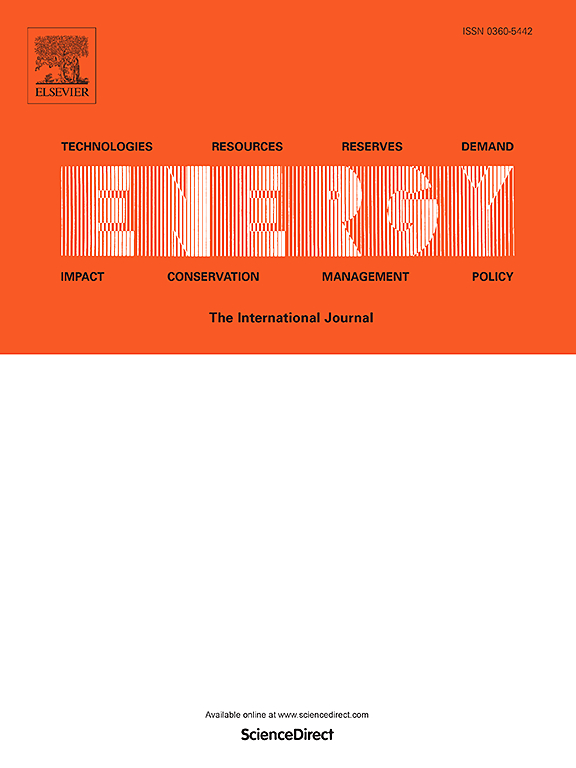喷油压力和喷管尺寸对氨/柴油双燃料发动机燃烧特性和污染物形成的影响
IF 9
1区 工程技术
Q1 ENERGY & FUELS
引用次数: 0
摘要
氨/柴油双燃料发动机受预混氨特性影响,火焰传播速度慢,导致燃烧恶化,污染物排放高。为了解决这些问题,本研究构建了氨/柴油双燃料发动机的三维数值模型,并根据实验数据完成了验证。模拟了氨混合比为40%时,柴油喷射压力(DIP)和喷油孔直径(DOD)的协同效应。结果表明,DIP和DOD的增加促进了柴油质量流量的增加,并伴随着射流湍流和轴向扩散的增强。在小孔直径较小的情况下,低DIP的应用导致扩散燃烧突出,延长了点火延迟和燃烧持续时间。DOD或DIP的增加会加速多点点火效应,产生更多OH自由基,促进NH3+OH↔H2O + NH2反应。这导致更高的指示热效率(ITE)和指示平均有效压力(IMEP)。在孔径较大的情况下,采用较高的DIP可以提高燃烧效率,减少NOx以外的污染物的排放。由于燃料NOx固定,较大的参数组合会产生更多的局部热点,从而增加热NO排放。过于集中的燃烧会导致最大压力上升速率超过1 MPa/°CA的允许值,影响发动机的稳定运行。因此,应淘汰DOD和DIP过大的组合方案。在(0.31 mm,80 MPa)方案下获得最佳的ITE和IMEP,分别为40.91%和1.04 MPa。未燃NH3、CO、HC和Soot的排放趋势与NOx相反。(0.26 mm, 120mpa)是最佳解决方案。与最优的发动机动力方案相比,牺牲少量的ITE和IMEP以换取排放清洁度的大幅提高是可以接受的。优化方案的燃油经济性和燃油经济性比原柴油机喷射方案提高了3.04%。未燃烧NH3排放量减少99.1%,仅为0.01 g/kW·h,温室气体总排放量减少262.4 g/kW·h,减少40.5%。本文章由计算机程序翻译,如有差异,请以英文原文为准。
An insight into the effects of injection pressure and nozzle dimension on combustion characteristics and pollutant formation of ammonia/diesel dual-fuel engines
The ammonia/diesel dual-fuel engine is affected by the characteristics of premixed ammonia, and the flame propagation rate is slow, resulting in combustion deterioration and high pollutant emissions. To solve these problems, this study constructed a three-dimensional numerical model of the ammonia/diesel dual-fuel engine and completed the verification based on the experimental data. The combustion and pollutant emissions of the mixtures in the combustion chamber were simulated to analyze the synergistic effects of diesel injection pressure (DIP) and orifice diameter (DOD) at an ammonia blending ratio of 40 %. The results demonstrate that an increase in DIP and DOD promotes a rise in diesel mass flow rate, accompanied by enhanced jet turbulence and axial diffusion. Under the condition of a small orifice diameter, the application of lower DIP leads to prominent diffusion combustion, which prolongs the ignition delay and combustion duration. The increase in DOD or DIP accelerates the multi-point ignition effect, generating more OH radicals and promoting the reaction NH3+OH↔H2O + NH2. This leads to higher indicated thermal efficiency (ITE) and indicated mean effective pressure (IMEP). Under large orifice diameters, the application of higher DIP enhances combustion efficiency and reduces emissions of pollutants other than NOx. Due to the fixed fuel NOx, larger parameter combinations generate more local hotspots, thereby increasing thermal NO emissions. Excessively concentrated combustion can cause the maximum pressure rise rate to exceed the allowable value of 1 MPa/°CA, affecting the stable operation of the engine. Therefore, the combination schemes with excessively large DOD and DIP should be eliminated. The best ITE and IMEP are obtained under the (0.31 mm,80 MPa) scheme, which are 40.91 % and 1.04 MPa, respectively. The emissions of unburned NH3, CO, HC, and Soot show opposite trends to NOx. The (0.26 mm, 120 MPa) is the best solution. Compared with the optimal engine power scheme, it is acceptable to sacrifice a minor amount of ITE and IMEP in exchange for substantial improvements in emission cleanliness. The ITE and IMEP of the optimized scheme are 3.04 % higher than those of the original diesel injection configuration. The unburned NH3 emissions are reduced by 99.1 %, leaving only 0.01 g/kW·h, and the total greenhouse gas emissions decrease by 262.4 g/kW·h, a 40.5 % reduction.
求助全文
通过发布文献求助,成功后即可免费获取论文全文。
去求助
来源期刊

Energy
工程技术-能源与燃料
CiteScore
15.30
自引率
14.40%
发文量
0
审稿时长
14.2 weeks
期刊介绍:
Energy is a multidisciplinary, international journal that publishes research and analysis in the field of energy engineering. Our aim is to become a leading peer-reviewed platform and a trusted source of information for energy-related topics.
The journal covers a range of areas including mechanical engineering, thermal sciences, and energy analysis. We are particularly interested in research on energy modelling, prediction, integrated energy systems, planning, and management.
Additionally, we welcome papers on energy conservation, efficiency, biomass and bioenergy, renewable energy, electricity supply and demand, energy storage, buildings, and economic and policy issues. These topics should align with our broader multidisciplinary focus.
 求助内容:
求助内容: 应助结果提醒方式:
应助结果提醒方式:


